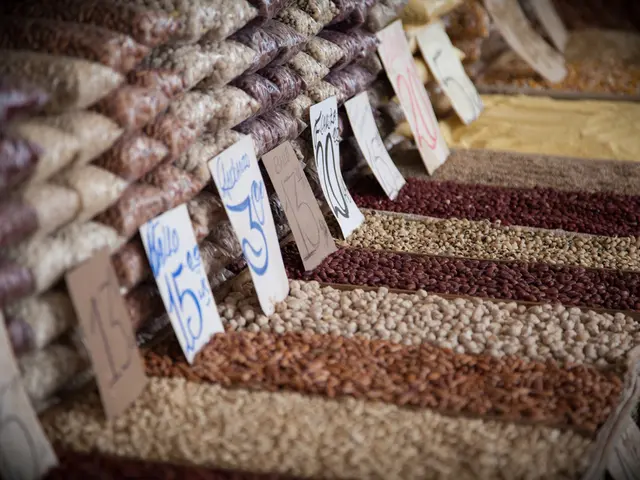Cultivation, Gathering, and Consumption of Jerusalem Artichoke (Sunchoke)
Sunchokes, a cousin of the sunflower, are a fascinating, low-maintenance plant hailing from North America. These guys are known for their tubers containing up to 75% inulin by dry weight – a pretty cool fiber that supports gut health and digestion (Shao et al., 2020). But the inulin content can fluctuate due to various factors.
Sunchoke Varieties: Different sunchoke varieties have varying inulin contents, so picking the right one can make a difference (Sennoi & Puttha, 2021).
Growing Conditions: The soil composition and cultivation practices can affect the inulin content, so making sure your soil's on point is essential (Pinmongkholgul et al., 2021).
Storage Time: Fresh tubers boast higher inulin content. Inulin sensitivity to cold temperatures means it decreases in cold storage conditions or after several frost events if the tubers remain in the ground (Sennoi & Puttha, 2021).
With its potential benefits, such as alleviating type 2 diabetes due to modulating the large intestine microflora, sunchokes are a valuable crop for food and industrial applications. Plus, they've got potential as a biofuel feedstock, with ethanol yields comparable to or higher than crops like corn and sugarcane (Bogucka et al., 2021).
Growing Sunchokes
Sunchokes thrive in full sun and require regular water inputs, a close eye on soil moisture, and fertilizer with a balanced NPK ratio. Mulching with straw can help regulate soil moisture. Proper watering, fertilizing, and gardening care promote healthy sunchoke plants and maximize tuber yields at harvest time (USDA, 2021).
Adding Sunchokes to Your Garden
Sunchokes are great for gardens, producing yellow, sunflower-like flowers that attract bees and contribute to pollination and biodiversity. These plants grow densely and can reach up to 10 feet, so it's a good idea to use stakes for support during the growing season.
Harvesting Your Sunchokes
Most sunchoke harvest happens in October after the first frost. The process involves cutting the stems, clearing the soil, and carefully digging around the stems to expose underground structures. A soil search must follow to ensure all tubers are collected (USDA, 2021).
Using Sunchokes
Sunchokes come in two main products: tubers and forage. Tubers are more popular and have various applications in the kitchen, while forage is mainly used in livestock feed.
Tuber Applications: Kitchen-wise, sunchokes are a versatile ingredient in mashing, roasting, soups, and even chips. They're valuable as raw materials for producing ethanol, butanol, succinic acid, citric acid, lactic acid, and other bioactive compounds due to their rich chemical composition and good resistance to environmental stressors (Bogucka et al., 2021; Sawicka et al., 2020).
Health-wise, sunchoke products are rich in bioactive compounds like inulin and its derivatives, which may help lower blood pressure, cholesterol, triglycerides, and glucose levels, aid in weight loss, support metabolism, act as antioxidants, and detoxify the body (Sawicka et al., 2020).
Wrapping Up
Sunchokes are a valuable crop in many industries, including food, chemicals, pharmaceuticals, and livestock feed. They're attractive due to their ease of cultivation, affordability, and diverse health benefits to consumers (USDA, 2021).
Additional Resources: USDA plant profile database
References:
- Bogucka et al., 2021
- Pinmongkholgul et al., 2021
- Razmkhah et al., 2017
- Sawicka et al., 2020
- Sennoi & Puttha, 2021
- Shao et al., 2020
- Swanton et al., 1992
Enrichment Data:
To optimize inulin content in sunchoke tubers, pay close attention to sunlight, soil, planting depth, spacing, water management, and overall plant health.
- Sunchokes thrive in full sunlight with at least 6 hours of direct sun daily for vigorous growth and development (1, 3).
- They prefer loose, well-drained soil to allow tubers to expand easily, while good drainage is critical to prevent tuber rot (1, 4).
- Plant tubers 4-5 inches deep, spaced 12-18 inches apart to reduce competition for nutrients and light, promoting tuber growth (3).
- Maintain consistent soil moisture, avoiding waterlogging, which can harm tuber quality (4).
- Harvest after the first frost for optimal inulin content, as cold exposure may increase fructan accumulation (from broader studies on sunchoke cultivation) (1, 4).
- The varying inulin content in different sunchoke varieties can make a significant difference in terms of nutrition and health-and-wellness benefits.
- Proper care, such as providing full sun, regular water inputs, and a balanced fertilizer with NPK, aids in the conservation of natural resources and yields healthy sunchoke plants.
- Apart from health benefits, sunchokes have potential applications in agriculture, particularly as a biofuel feedstock, due to ethanol yields comparable to or higher than traditional crops like corn and sugarcane.
- Mulching with straw can help maintain soil moisture and promote sunchoke growth, which is essential for maximizing tuber yields.
- Sunchoke plants, with their yellow sunflower-like flowers, contribute positively to the global-cuisines landscape by offering versatile ingredients for cooking, such as mashing, roasting, soups, and even chips.
- In addition to lowering blood pressure, cholesterol, triglycerides, and glucose levels, sunchoke products are also rich in bioactive compounds that support metabolism, act as antioxidants, and detoxify the body.
- By optimizing sunchoke cultivation through techniques like proper sunlight, soil management, and harvesting time, we can ensure the highest inulin content for various food-and-drink and industry applications.
- For those interested in growing sunchoke and understanding more about their cultivation, the USDA plant profile database serves as an excellent resource.







